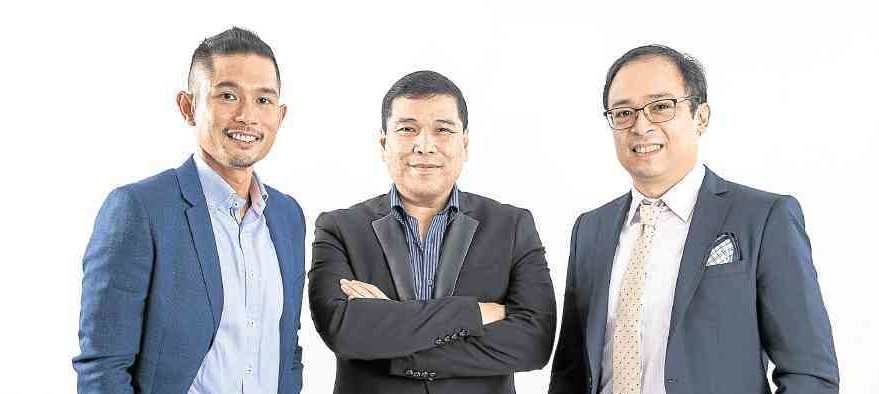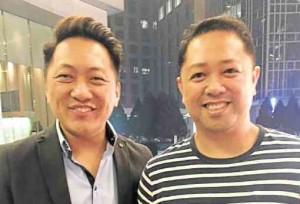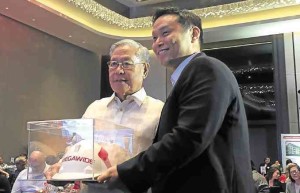PH’s new breed of tycoons
They are young, bold and resourceful. They all are from the Generation X (born between 1965 and 1980), the demographic bridge between the baby boomers and the millennials.
They built their own companies out of their own passion and vision, contributing to wealth and job creation. None of them was raised in poverty but none came from ultra-rich families. They did not inherit their companies from their parents. Before the age of 40, they listed the companies they founded and gained access to the capital markets while subjecting their enterprises to greater public scrutiny and accountability.
Imagine where they could be in decades to come.
Edgar “Injap” Sia II
Mang Inasal, DoubleDragon Properties
He never had to reinvent the wheel but he knows how to spot opportunities and thrive even in highly competitive segments like fast-food or real estate. His is a story of a provincial lad who had the vision and who knew how to compete and even turn competitors into allies.
Born in the 1997 lunar “Year of the Dragon,” Injap was raised in Roxas City, Capiz, until the age of 12. He later went to Iloilo for high school and college studies. He visited a Jollibee store in Manila for the first time when he was 11 and even posed with The Bee, not knowing that decades after, this restaurant chain would alter the course of his history and make him one of the new-generation billionaires.
He took up Architecture in the University of San Agustin in Iloilo but dropped out of college to focus on his entrepreneurial ventures. He had been an entrepreneur since 20, initially dabbling into photo-developing store and running a three-star hotel and a laundry shop.
One Sunday in 2003, he called up his dad to borrow P2 million to put up his very first Mang Inasal grilled chicken restaurant. Everyday, he would go to the first Mang Inasal store in Iloilo to help with the store operations and to grill the chicken. He had limited capital and had no experience in running a restaurant at all. He and his wife worked long hours for many years, manually mixing the marinade.
Yet he was ready to compete head on, not intimidated to branch out in areas where fast-food giant Jollibee was nearby. Mang Inasal offered unlimited rice to diners even at a time when there was a rice crisis. He gained the respect of Jollibee founder Tony Tan Caktiong. Five years ago, Jollibee bought a 70-percent stake in Mang Inasal for P3 billion. Apart from raising cash, Injap gained a business partner in Tony, a fellow “Dragon” who became his partner in the real estate business.
Injap also started a real estate company—Injap Land Corp.—in 2009, one which initially worked on provincial projects. In 2011, he also formed Hotel of Asia Inc. (HOA), a joint venture with Oishi founder Carlos Chan and Steniel Development Corp., which focuses on hotel ventures such as Hotel 101 and JinJiang Inn-Philippines.
It was in 2012 that the Tan Caktiong family bought into Injap Land, which became a 50/50 joint venture and renamed DoubleDragon Properties Corp., focusing on residential and commercial developments. This venture is now working to build 100 community shopping malls by 2020 but is likewise into residential and office development. Seeing its potential, the country’s biggest conglomerate—SM Investments Corp.—acquired a 34-percent stake in DoubleDragon’s subsidiary CityMall Commercial Centers Inc. (CMCCI), which is building the community malls. In April 2014, when Injap was 37, DoubleDragon debuted on the Philippine Stock Exchange.
DoubleDragon is currently valued by the stock market at P131 billion. At age 39, Injap’s 37-percent stake in the property firm is thus worth around P48.5 billion.
Earlier this year, Injap decided to sell his group’s remaining 30-percent stake in Mang Inasal to Jollibee for P2 billion, adding to his war chest.
Meanwhile, the hotel business under HOA was consolidated into DoubleDragon. By this time, it has 855 hotel rooms under its wings, allowing DoubleDragon to benefit from the booming tourism prospects for the Philippines. Chan and Staniel retained ownership of 15 percent each in HOA.
“Despite the very challenging journey of being a new player competing in a traditional and mature industry, which for many decades has been dominated by established large players, the whole DD team will continue to work very hard and keep its sheer determination and intense passion in driving DoubleDragon to breakthrough and become one of the largest and strongest property companies in the Philippines and create a lasting and positive impact to all its stakeholders,” Injap said.
Outside of his multiple businesses, Injap’s group gives back to the community through Injap Foundation. This charity arm has donated the four-story Iloilo City Community College Building, the Catholic Parish Church Building in Cagay, Roxas City, The Pavilion in Gawad Kalinga Enchanted Farm in Bulacan and The Community Center Building in Tanza, Iloilo City.
Meanwhile, Injap finally got a diploma 14 years after dropping out of college as his old school, University of San Agustin, conferred him with a doctorate degree (honoris causa). Injap is a TOYM (The Outstanding Young Men) honoree (Class of 2011). He was also honored Ernst & Young’s Small Business Entrepreneur (for Mang Inasal) of the Year in 2010.
In his free time, Injap enjoys reading or watching documentaries about successful companies and successful business people around the world. About a decade and a half ago, he named his second son John Henry—combining the names of nonagenarian tycoons John Gokongwei and Henry Sy.
“Later on, I found out that Mr. Henry Sy Sr.’s Chinese name is also ‘Chi Seng’—same as my Chinese name ‘Chi Seng.’ When I learned that many years ago I was so happy,” he said.
“I can’t imagine before that one day, I will be working closely with people like them and I continue to learn a lot from them. I am blessed to have a chance to work closely and to be surrounded by older and more seasoned businessmen in the country. The wisdom that you can pick up is very valuable,” said Injap.
Michael Cosiquien and Edgar Saavedra
Megawide Construction
At the height of the Asian currency crisis in 1997, two civil engineers from De La Salle University decided to put up a construction firm. Never mind that the property markets across the region were in the doldrums. Both came from entrepreneurial families. Taking risk was in their DNA.
“One might say that qualities like being too young, too adventurous, not knowing enough, are weaknesses that keep you from being successful, but this is not true. All we had were guts and a drive to succeed,” the 41-year-old Edgar said in a speech before Anvil Business Club, an association of young Filipino-Chinese entrepreneurs.
“Sometimes inexperience can be good. It forced us to come up with new ideas that set us apart from the rest,” Edgar said.
Edgar obtained his Bachelor of Science degree in Civil Engineering from DLSU in 1996 and became a licensed civil engineer in the same year. He specializes in European building technologies and advanced formwork systems. He obtained training in German formwork system and basic occupational safety and health, and attended special studies on foundation works sponsored by the Philippine Institute for Civil Engineers.
Michael, who was a batch ahead of Edgar in DLSU, graduated in 1995 and passed the government licensure board examination for Civil Engineering in 1995. He is now 43 years old.
In 2004, Michael and Edgar incorporated Megawide Construction Corp. (MWIDE), employing advanced technology building systems such as precast concrete and formwork systems in its projects. Michael has become chair and Edgar has been the president since incorporation.
When Megawide was a startup construction firm, the young businessmen exerted effort in personal research and forming professional relationships. “The internet and e-mail were relatively new back then but we took advantage of the connectivity they offered,” Edgar recalled.
Edgar reckons that formwork equipment and prefabricated concrete were new technologies that had given Megawide the edge over competitors.
“We were young and we had nothing to lose. We turned our failures into experience and experience into skill,” he said.
After a sluggish start, Megawide got a big break in 2007 when it won two big projects of SM Development Corp. (SMDC), the residential arm of the Sy family. It built Berkeley and Grass Residences. For a time, 70 percent of its business was derived from the residential projects contracted by SMDC.
By 2011, when the two founders were in their late 30s, Megawide took a big leap by going public. The Sy family supported Megawide’s public listing by becoming a cornerstone investor in the company.
Since becoming a public company, Megawide started to diversify from a primarily residential property contractor into an infrastructure firm. It started bidding for—and winning—big infrastructure projects offered by the government under the public-private partnership (PPP) framework. It has built close to 10,000 classrooms under the school building infrastructure PPP. It bagged a hotly contested project to redevelop the Mactan-Cebu International Airport in partnership with GMR of India. The 25-year build-operate-transfer contract includes the renovation of all landside facilities and the construction of a second passenger terminal. Earlier this year, Megawide reported the first full-year revenues of subsidiary GMR-Megawide Cebu Airport Corp. (GMCAC) at P1.48 billion, attributed to strong aeronautical, commercial and rental revenues driven by a 15.5-percent increase in passenger growth.
Meanwhile, the Southwest Integrated Transport Terminal (SWITS) is positioned as Megawide’s entry into the progressive property sector. SWITS is expected to bring in a mix of transportation infrastructure supported by mixed-use retail and commercial recurring revenues. The 35-year build-transfer-operate contract was signed in 2015.
To date, Megawide is valued by the stock market at P29.7 billion. Last August, Megawide agreed to buy back the 17-percent stake held by the family of tycoon Henry Sy Sr. through Sybase Equity Investment Corp. for P4.6 billion. As such, 74 percent of Megawide is now owned by Michael and Edgar’s Citicore Holdings Investment Inc. The buyback of shares gave Megawide a free hand to invest more in power generation, which it could not do with the Sy family as an investor because of the Sys’ investment in National Grid Corp., the country’s electricity superhighway (existing laws cap a group’s allowable stake in power generation as a ratio of attributable distribution capacity).
Megawide also agreed to buy the renewable energy (RE) business of its controlling shareholders under Citicore Power Inc., kicking off a five-year diversification plan to transform from a construction and engineering firm into a fully diversified infrastructure conglomerate. Citicore Power is a renewable energy company with a commitment to produce 1,000 megawatts (MW) of clean energy such as solar, biomass, wind and hydropower. It operates three solar power projects in the provinces of Bataan, Negros Occidental and Cebu that collectively produce more than 100 MW of electricity going to the national grid.
Under the new structure envisioned by the group, Megawide’s core businesses will be in four areas: Construction, airport operation, transport and power generation with a focus on renewable energy. In 2015, construction contributed 66 percent of total income, with the airport business bringing in 34 percent.
“Megawide is already at its prime as a construction company. More than ever, it is capable of providing the most basic and one of the important components of these businesses and that is EPC (engineering, procurement and construction),” Michael said.

From left, president and chief operating officer Raymond Racaza, chair and chief executive officer Nico Jose “Nix” Nolledo, and chief technology officer Fernando Jude Garcia of Xurpas Inc.
Nico Jose “Nix” Nolledo, Raymond Gerard Racaza and Fernando Jude Garcia
Xurpas Inc.
Nix is not the techie guy but he had a flair for entrepreneurship. As an undergraduate student at Ateneo de Manila University, he ran a cafeteria in Elizabeth Seaton School and a PlayStation arcade in BF Homes, but had difficulty balancing school with business. The tedious schedule and his loads in school didn’t allow him to succeed in his initial business ventures. These businesses were already closed by the time he graduated with a degree in BS Management.
Then a challenging job-hunting started. It was 1998 or just a year after the Asian currency crisis and jobs were scarce. He literally walked the entire stretch of Ayala Avenue, going from one company to another to submit his resume, but could not find a job. Thinking that one couldn’t go wrong with food, he finally found a job as an assistant manager at KFC, initially assigned at SM North Edsa.
Then, a brother who was living in the US gave Nix the idea to put up an Internet-based message board, a forum where people of common interests can meet and talk. The idea of creating a community and segments of the community on the basis of areas of interest paved the way for the establishment of Pinoyexchange.com. Its first template was designed on a powerpoint because he was no programmer. Usage of Pinoyexchange.com grew exponentially when a forum on UAAP was created. When Nix saw that the messaging board was hitting 20,000 unique visitors a month, he imagined: That’s like filling the Araneta Coliseum with people. “That’s something that blew my mind: That I could create something that 20,000 people liked. That’s when I saw the potential of the internet,” he said.
But for lack of money and with the cost of web hosting rising, Nix couldn’t support the exponential growth of his venture. Thus, when the Ayala group’s internet investment arm iAyala approached him with an offer to invest in Pinoyexchange, he immediately signed a deal.
After being integrated into the Ayala group, he saw research reports that estimated that cellphones had outnumbered PCs at a ratio of three to one. This prompted Nix to request to be transferred to the wireless solutions department. Since the cost per unit of a cellphone is much cheaper than the PC or the laptop, he foresaw the explosion in mobile internet usage and the big business it would bring to companies developing mobile content.
With that vision, he left iAyala to put up Xurpas in partnership with the more techie Raymond and Jude. It was a bet on a mobile future for consumers, riding on the explosion of internet connectivity and mobile phone use.
With a seed capital of P62,500 in 2001, the three young technopreneurs created Xurpas, a technology company specializing in the creation and development of digital products and services for mobile users. Its portfolio includes online casual games, messaging and the so-called social discovery applications, as well as call/SMS/data bundles, peer-to-peer mobile airtime credit transfers and mobile commerce. It is a company that serves both the consumers and enterprises. By the time it listed on the PSE on Dec. 2, 2014, Xurpas had served about four million customers.
The triumvirate behind Xurpas thus took advantage of the low barriers to enter the digital space and built a thriving business around it.
“I’ve always been in love with technology and I’ve always believed in the taipans of yesteryears: They built their fortunes on property. They knew how to build communities. And I’ve always believed that the taipans of tomorrow are people who are also builders of communities but, with the internet, they build communities that have no boundaries,” Nix said.
Raymond served as treasurer and chief operating officer of Xurpas since inception in 2001. He holds a BS degree in Computer Science, Major in Information Technology from De La Salle University. Before co-founding the company, he was a senior solutions consultant at Wireless Internet Solutions Inc. and was part of the original development team of iAyala that built the first Wireless Application Protocol (WAP) site in the Philippines. Earlier this year, Raymond became president of Xurpas while Nix remained as chair.
Fernando Jude, on the other hand, has been chief technology officer of Xurpas since co-founding the company with Nix and Raymond. Armed with a BS degree in Applied Physics from the University of the Philippines in Diliman, he was a software developer in iAyala.
He created Xurpas’ Griffin Platform, the mobile consumer content gateway and platform for all of its mobile consumer content products and services. He also created the Xurpas’ modular middleware system that can easily integrate with any modern billing gateway. He is the chief engineer responsible for the company’s software architecture and systems integration.
Since its P1.36-billion IPO two years ago, Xurpas has had a string of overseas investments as part of its diversification program. Xurpas invested $14 million in six offshore technology companies. It gained access to populous China by buying into Micro Benefits Ltd., a Hong Kong-based company providing innovative human resources (HR) solutions to topnotch companies in the mainland.
Xurpas also recently returned to the capital market, raising P1.2 billion in fresh capital from a “top-up” equity deal, replenishing its war chest for future expansion while widening public ownership. The three founding shareholders of Xurpas sold around P2.5 billion worth of shares to new investors but ploughed back nearly half of the proceeds in the equity deal that widened the tech company’s public float to 30.6 percent from 22.9 percent. At the same time, Nix, Raymond and Jude pocketed some gains from the share price appreciation seen since Xurpas went public. Each modestly pared their stake to 23.1 percent from 25.7 percent. With Xurpas valued by the market now at around P25 billion, each founder’s remaining stake is thus worth around P5.8 billion.
Meanwhile, in the absence of a robust venture capital industry, Nix has been an active angel investor in more than 20 Philippine startups as well as in some overseas tech companies. He is an angel investor in social news networking site Rappler.com; ACommerce, the biggest e-commerce supply chain company in the region; and Kalibrr, the only Philippine startup that has made it to the prestigious YCombinator incubation program. He has also co-founded two non-stock, non-profit organizations that helped advance the local technology industry: IMMAP (Internet and Mobile Marketing Association of the Philippines) as well as DCOM (The Digital Commerce Industry Association). He is also the Philippine venture partner of Wavemaker Pacific, a member of the DFJ Network, a tier 1 venture capital firm that has backed more than $400 billion worth of deals including Paypal, Tesla, SpaceX, Baidu, Twitter, Theranos and Skype.
Nix was the first Filipino entrepreneur chosen by the Endeavour network. He is also the Ernst and Young’s 2015 “Philippine Entrepreneur of the Year” and was a TOYM honoree (Class of 2015).



